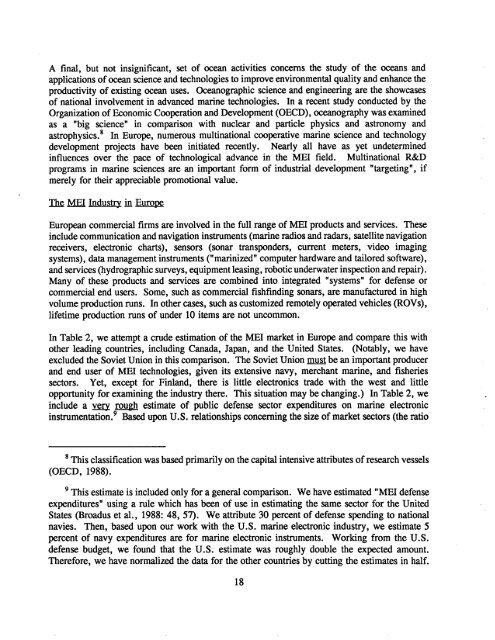WHOI-90-52
WHOI-90-52
WHOI-90-52
You also want an ePaper? Increase the reach of your titles
YUMPU automatically turns print PDFs into web optimized ePapers that Google loves.
A final, but not insignificat, set of ocea activities concerns the study of the ocs and<br />
applications of oc science and tehnologies to improve environmenta quality and enhance the<br />
productivity of existing oc uses. Ocographic science and engineering are the showcases<br />
of national involvement in advance marne technologies. In a recent study conducted by the<br />
Organization of Economic Cooperation and Development (OECD), ocography was examined<br />
as a "big science" in comparson with nuclea and parcle physics and astronomy and<br />
astrophysics.<br />
8 In Europe, numerous multinational cooperative marne science and technology<br />
development projects have been initiated recently. Nealy all have as yet undetermined<br />
influences over the pace of technologica advance in the MEI field. Multinational R&D<br />
programs in marne sciences are an importt form of industral development "tageting", if<br />
merely for their appreciable promotional value.<br />
The MEI Industr in Europe<br />
Europe commercial firms are involved in the full rage of MEI products and services. These<br />
include communication and navigation instrments (marne radios and radars, satellte navigation<br />
recivers, electronic chars), sensors (sonar transponders, current meters, video imaging<br />
systems), data management instruments ("marnize" computer hardware and talored software),<br />
and services (hydrographic surveys, equipment leasing, robotic underwater inspetion and repair).<br />
Many of these products and services are combined into integrated "systems" for defense or<br />
commercial end users. Some, such as commercial fish<br />
finding sonars, are manufactured in high<br />
volume production runs. In other cases, such as customized remotely<br />
operated vehicles (ROVs),<br />
lifetime production runs of under 10 items are not uncommon.<br />
In Table 2, we attempt a crude estimation of the MEI market in Europe and compare this with<br />
other leading countres, including Canada, Japan, and the United States. (Notably, we have<br />
excluded the Soviet Union in this comparson. The Soviet Union must be an importt producer<br />
and end user of MEI technologies, given its extensive navy, merchant marne, and fisheries<br />
sectors. Yet, except for Finland, there is little electronics trade with the west and little<br />
opportunity for examining the industry there. This situation may be changing.) In Table 2, we<br />
include a very rough estimate of public defense setor expenditures on marne electronic<br />
instrmentation.9 Base upon U.S. relationships concerning the size of market setors (the ratio<br />
8 This classification was base primarly on the capita intensive attributes of reseach vessels<br />
(OECD, 1988).<br />
9 This estimate is included only for a genera comparson. We have estimated "MEI defense<br />
expenditures" using a rule which has been of use in estimating the same setor for the United<br />
States (Broadus et al., 1988: 48, 57). We attrbute 30 percent of defense spending to national<br />
navies. Then, base upon our work with the U.S. marne electronic industr, we estimate 5<br />
percent of navy expenditures are for marne electronic instrments. Working from the U.S.<br />
defense budget, we found that the U.S. estimate was roughly double the expeted amount.<br />
Therefore, we have normalized the data for the other countries by cutting the estimates in half.<br />
18
















